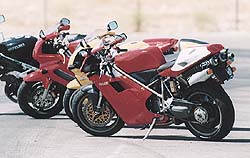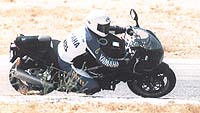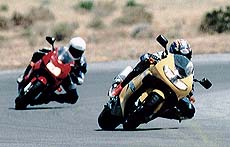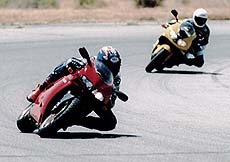The Best of the Best: Part II

Super Twins
LOS ANGELES, August, 1998 -- Screw the real world, Part II: In this, our second of a three-part series, we continue to care little about reality, gas mileage, good manners, ergonomics, whether or not you can afford any of the new models we test or anything else morally and politically correct. In our shallow little microcosm of free bikes, year-round sun, beautiful women, thousands of miles of the best canyon roads in the world and a rotisserie of company (read: tax deductible) checks available to rent racetracks, insure our precious wazoos to the hilt and buy needed gear with abandon, the only thing that matters is eloquently summed up by guest tester, musician and Hollywood expatriate Erick Stangg: "Fast bikes get chicks, man." Since our entire staff are single males with too much time on their hands to ponder such stupid statements (no, it never occurred to us that being speed-driven pigs is the primarily reason we're unable to find decent chicks to marry, so don't bother pointing it out), we decided to settle the matter once and for all. In Best of the Best, Part I, we determined that Yamaha's YZF-R1 is the king of inline sportbikes, and here, now, we'll settle the score of which twin-cylinder sportbike is the best made. In the third part of this series, we'll square off today's winner against the mighty R1 to crown the Grand Pooh-Bah of sportbikes. Stay tuned.
In our shallow little microcosm of free bikes, year-round sun, beautiful women, thousands of miles of the best canyon roads in the world and a rotisserie of company (read: tax deductible) checks available to rent racetracks, insure our precious wazoos to the hilt and buy needed gear with abandon, the only thing that matters is eloquently summed up by guest tester, musician and Hollywood expatriate Erick Stangg: "Fast bikes get chicks, man." Since our entire staff are single males with too much time on their hands to ponder such stupid statements (no, it never occurred to us that being speed-driven pigs is the primarily reason we're unable to find decent chicks to marry, so don't bother pointing it out), we decided to settle the matter once and for all. In Best of the Best, Part I, we determined that Yamaha's YZF-R1 is the king of inline sportbikes, and here, now, we'll settle the score of which twin-cylinder sportbike is the best made. In the third part of this series, we'll square off today's winner against the mighty R1 to crown the Grand Pooh-Bah of sportbikes. Stay tuned.Suzuki TL1000S
 In last year's Sport Twins Shootout, we judged the 1997 TL1000S as the sharper sportbike over the VTR1000. We loved the TLS's awesome 114 horsepower motor that produced a peak torque of 72.6 ft-lbs at 7750 rpm. With its steep steering head angle and short trail (23.7 degrees and 3.7 inches, respectively), the TLS begged to be flicked into corners.
In last year's Sport Twins Shootout, we judged the 1997 TL1000S as the sharper sportbike over the VTR1000. We loved the TLS's awesome 114 horsepower motor that produced a peak torque of 72.6 ft-lbs at 7750 rpm. With its steep steering head angle and short trail (23.7 degrees and 3.7 inches, respectively), the TLS begged to be flicked into corners.But due to liability concerns, Suzuki retro-fitted all TLS models with a steering damper. This year, they de-tuned the motor as well: The EFI map was reprogrammed to calm down low-end throttle response. We measured only 108 hp compared to 114 hp for last year pre-production unit. So what we considered a powerful, flickable sportbike as been neutered somewhat into a slower turning, less powerful street bike. The attributes that made the TL1000S such a blast to ride at the track -- light, quick handling and a powerful, quick-revving motor -- have been diminished. What we didn't like about the TLS remains. It still doesn't want to hold a line through the corners. The rear cylinder heats the rear rotary damper which makes the rear suspension prone to fade -- a real problem, since the rotary shock isn't that good to begin with -- while there is too much spring and compression in the front. The fuel-injection mapping problems that plagued earlier models seem to have been fixed, but occasionally our test bike stalled at idle. Overall, we were disappointed with the track performance of the '98 TL1000S.
Suzuki TL1000R
 Runner up on the track was the Suzuki TL1000R. Other than sharing the TL1000 name, the R and the S share the same basic powerplant configuration -- a 996cc, 90-degree, liquid-cooled engine -- and not much else. This is a completely different motorcycle designed to have the potential to win superbike races. The TLR produces more torque and horsepower than the TLS, using twin 52mm injectors per cylinder, lighter connecting rods and forged pistons. It's also more aerodynamic with a full fairing, slanted nose and tucked in silencers. Shorter intake tracts allowed Suzuki to increase the airbox volume and design the gas tank to be lower and narrower at the rear, allowing the rider to tuck further inside for a more comfortable ride on the street.
Runner up on the track was the Suzuki TL1000R. Other than sharing the TL1000 name, the R and the S share the same basic powerplant configuration -- a 996cc, 90-degree, liquid-cooled engine -- and not much else. This is a completely different motorcycle designed to have the potential to win superbike races. The TLR produces more torque and horsepower than the TLS, using twin 52mm injectors per cylinder, lighter connecting rods and forged pistons. It's also more aerodynamic with a full fairing, slanted nose and tucked in silencers. Shorter intake tracts allowed Suzuki to increase the airbox volume and design the gas tank to be lower and narrower at the rear, allowing the rider to tuck further inside for a more comfortable ride on the street. The TLR was built around an aluminum twin-spar frame. Power delivery is linear, and the much heavier R (the R weighs 491 pounds wet compared to the S's 432-pounds) wants to keep the front end on the ground. It still possesses Suzuki's controversial rear rotary damper, but it's been redesigned around an automatic temperature compensation system that keeps the damping oil from heating up and becoming thinner. While this works in theory and, compared to the S, in practice as well, the rotary damper's valving and overall performance still lags behind conventional shocks -- especially the Ohlins unit fitted on the Duck.
The TLR was built around an aluminum twin-spar frame. Power delivery is linear, and the much heavier R (the R weighs 491 pounds wet compared to the S's 432-pounds) wants to keep the front end on the ground. It still possesses Suzuki's controversial rear rotary damper, but it's been redesigned around an automatic temperature compensation system that keeps the damping oil from heating up and becoming thinner. While this works in theory and, compared to the S, in practice as well, the rotary damper's valving and overall performance still lags behind conventional shocks -- especially the Ohlins unit fitted on the Duck.If this were a normal, sane MO test, the $9500 TLR might have prevailed over the $23,000 Ducati. But this is the Best of the Best Twins shootout, not the Best Twins That Most People Can Afford shootout, and the awesome Ducati 916SPS pulled past the pack and never looked back.